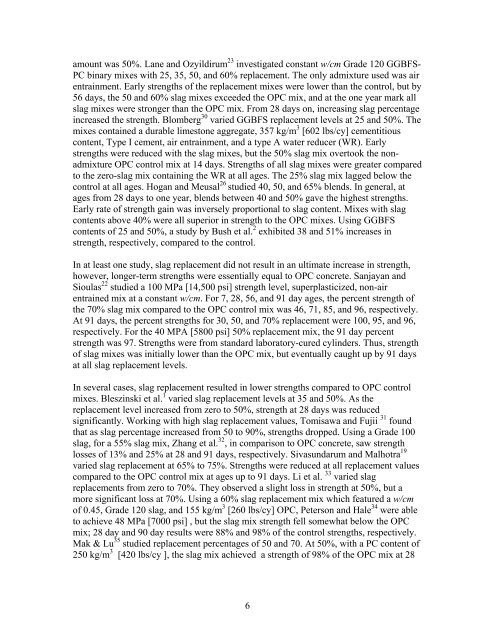Strength and Durability of a 70% Ground Granulated Blast Furnace ...
Strength and Durability of a 70% Ground Granulated Blast Furnace ...
Strength and Durability of a 70% Ground Granulated Blast Furnace ...
Create successful ePaper yourself
Turn your PDF publications into a flip-book with our unique Google optimized e-Paper software.
amount was 50%. Lane <strong>and</strong> Ozyildirum 23 investigated constant w/cm Grade 120 GGBFS-<br />
PC binary mixes with 25, 35, 50, <strong>and</strong> 60% replacement. The only admixture used was air<br />
entrainment. Early strengths <strong>of</strong> the replacement mixes were lower than the control, but by<br />
56 days, the 50 <strong>and</strong> 60% slag mixes exceeded the OPC mix, <strong>and</strong> at the one year mark all<br />
slag mixes were stronger than the OPC mix. From 28 days on, increasing slag percentage<br />
increased the strength. Blomberg 30 varied GGBFS replacement levels at 25 <strong>and</strong> 50%. The<br />
mixes contained a durable limestone aggregate, 357 kg/m 3 [602 lbs/cy] cementitious<br />
content, Type I cement, air entrainment, <strong>and</strong> a type A water reducer (WR). Early<br />
strengths were reduced with the slag mixes, but the 50% slag mix overtook the nonadmixture<br />
OPC control mix at 14 days. <strong>Strength</strong>s <strong>of</strong> all slag mixes were greater compared<br />
to the zero-slag mix containing the WR at all ages. The 25% slag mix lagged below the<br />
control at all ages. Hogan <strong>and</strong> Meusal 26 studied 40, 50, <strong>and</strong> 65% blends. In general, at<br />
ages from 28 days to one year, blends between 40 <strong>and</strong> 50% gave the highest strengths.<br />
Early rate <strong>of</strong> strength gain was inversely proportional to slag content. Mixes with slag<br />
contents above 40% were all superior in strength to the OPC mixes. Using GGBFS<br />
contents <strong>of</strong> 25 <strong>and</strong> 50%, a study by Bush et al. 2 exhibited 38 <strong>and</strong> 51% increases in<br />
strength, respectively, compared to the control.<br />
In at least one study, slag replacement did not result in an ultimate increase in strength,<br />
however, longer-term strengths were essentially equal to OPC concrete. Sanjayan <strong>and</strong><br />
Sioulas 22 studied a 100 MPa [14,500 psi] strength level, superplasticized, non-air<br />
entrained mix at a constant w/cm. For 7, 28, 56, <strong>and</strong> 91 day ages, the percent strength <strong>of</strong><br />
the <strong>70%</strong> slag mix compared to the OPC control mix was 46, 71, 85, <strong>and</strong> 96, respectively.<br />
At 91 days, the percent strengths for 30, 50, <strong>and</strong> <strong>70%</strong> replacement were 100, 95, <strong>and</strong> 96,<br />
respectively. For the 40 MPA [5800 psi] 50% replacement mix, the 91 day percent<br />
strength was 97. <strong>Strength</strong>s were from st<strong>and</strong>ard laboratory-cured cylinders. Thus, strength<br />
<strong>of</strong> slag mixes was initially lower than the OPC mix, but eventually caught up by 91 days<br />
at all slag replacement levels.<br />
In several cases, slag replacement resulted in lower strengths compared to OPC control<br />
mixes. Bleszinski et al. 1 varied slag replacement levels at 35 <strong>and</strong> 50%. As the<br />
replacement level increased from zero to 50%, strength at 28 days was reduced<br />
significantly. Working with high slag replacement values, Tomisawa <strong>and</strong> Fujii 31 found<br />
that as slag percentage increased from 50 to 90%, strengths dropped. Using a Grade 100<br />
slag, for a 55% slag mix, Zhang et al. 32 , in comparison to OPC concrete, saw strength<br />
losses <strong>of</strong> 13% <strong>and</strong> 25% at 28 <strong>and</strong> 91 days, respectively. Sivasundarum <strong>and</strong> Malhotra 19<br />
varied slag replacement at 65% to 75%. <strong>Strength</strong>s were reduced at all replacement values<br />
compared to the OPC control mix at ages up to 91 days. Li et al. 33 varied slag<br />
replacements from zero to <strong>70%</strong>. They observed a slight loss in strength at 50%, but a<br />
more significant loss at <strong>70%</strong>. Using a 60% slag replacement mix which featured a w/cm<br />
<strong>of</strong> 0.45, Grade 120 slag, <strong>and</strong> 155 kg/m 3 [260 lbs/cy] OPC, Peterson <strong>and</strong> Hale 34 were able<br />
to achieve 48 MPa [7000 psi] , but the slag mix strength fell somewhat below the OPC<br />
mix; 28 day <strong>and</strong> 90 day results were 88% <strong>and</strong> 98% <strong>of</strong> the control strengths, respectively.<br />
Mak & Lu 35 studied replacement percentages <strong>of</strong> 50 <strong>and</strong> 70. At 50%, with a PC content <strong>of</strong><br />
250 kg/m 3 [420 lbs/cy ], the slag mix achieved a strength <strong>of</strong> 98% <strong>of</strong> the OPC mix at 28<br />
6

















